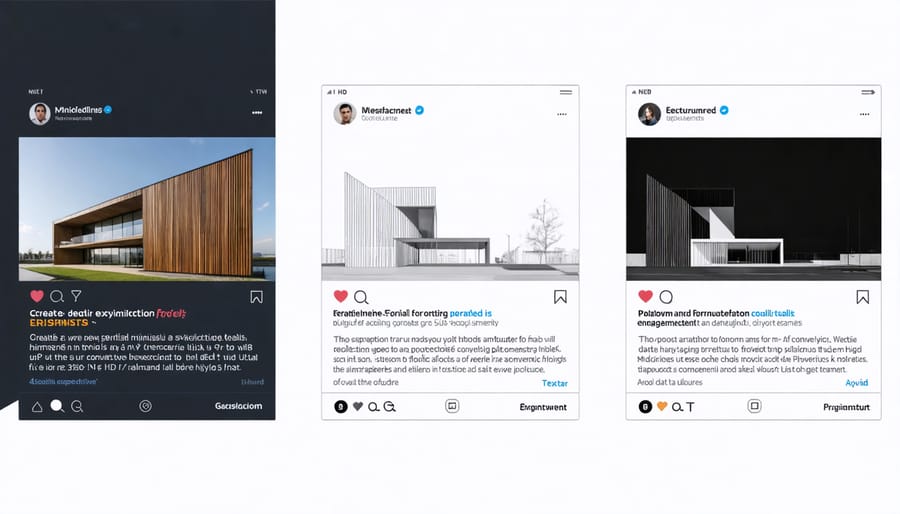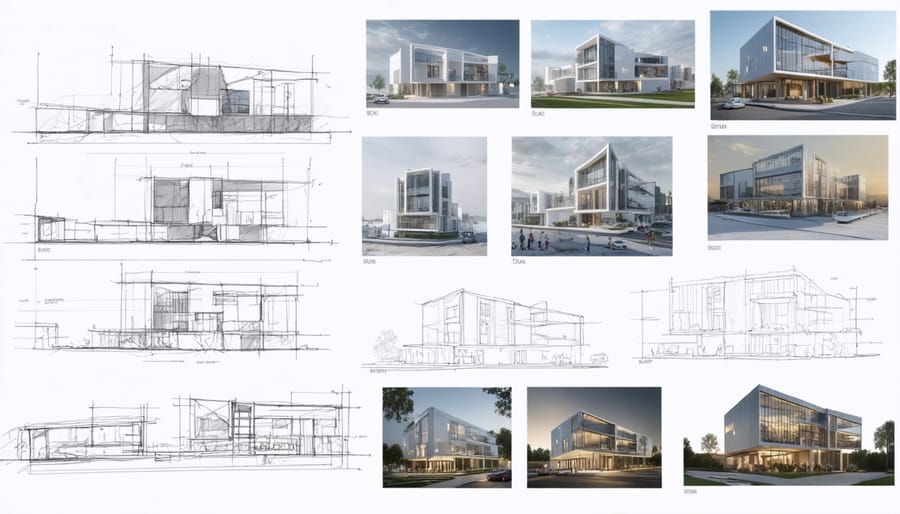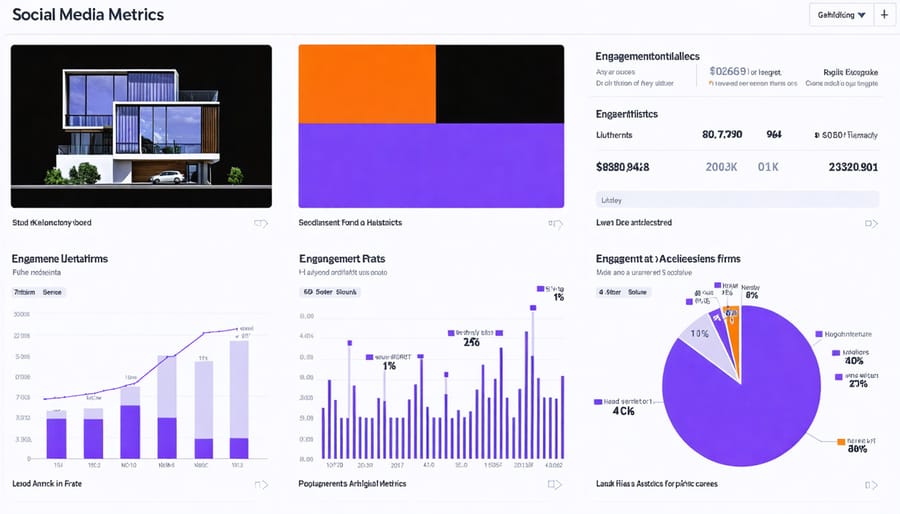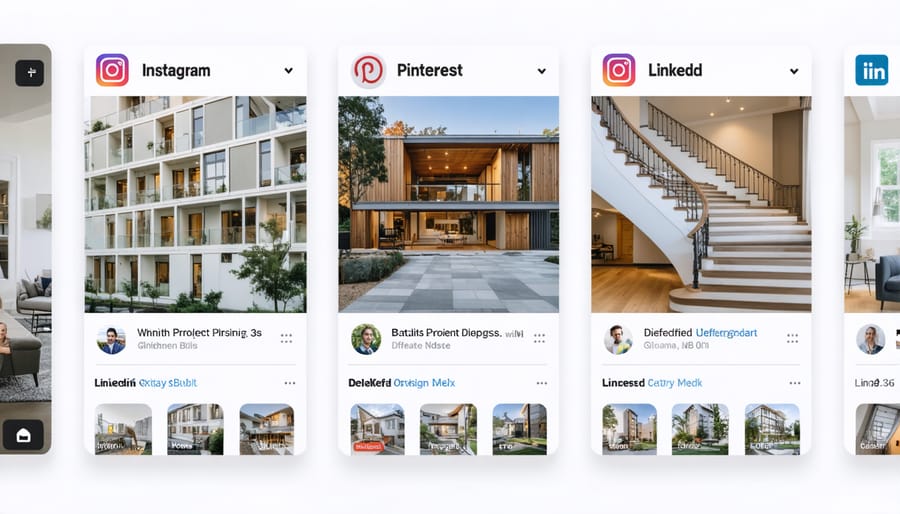Transform your architectural practice’s digital presence through strategic social media management that aligns with your professional portfolio. As a top provider of industry-specific marketing solutions demonstrates, architecture firms leveraging visual platforms achieve 40% higher client engagement rates than traditional marketing methods alone.
Showcase award-winning projects through carefully curated before-and-after sequences on Instagram, highlighting sustainable design elements and innovative structural solutions that resonate with both potential clients and industry peers. Establish thought leadership by sharing detailed case studies and technical insights on LinkedIn, where 78% of architecture professionals actively engage with content related to building innovation and design methodology.
Master the delicate balance between maintaining professional credibility and creating compelling content that drives meaningful engagement. While residential architects report a 65% increase in qualified leads through strategic social media presence, commercial firms consistently secure speaking engagements and industry partnerships through targeted content distribution across professional networks.
Visual Storytelling: The Architect’s Social Media Superpower
Platform-Specific Visual Strategies
Each social media platform demands a distinct visual approach to maximize engagement and professional impact. Instagram’s grid layout requires carefully curated project photography with consistent filters and formatting, ideally maintaining a 3:4 aspect ratio for optimal mobile viewing. Professional architectural photography should be complemented by behind-the-scenes content showing design processes and team collaboration.
Pinterest, with its vertical orientation, benefits from detailed architectural drawings, renderings, and infographics formatted in a 2:3 ratio. Create boards that showcase different project categories, material selections, and visual storytelling in construction processes to maximize searchability and user engagement.
LinkedIn demands more polished, corporate-focused visuals that emphasize professional achievements and project milestones. Use high-resolution project completion photos, team presentations, and industry event coverage. Incorporate branded graphics with data visualizations to showcase project metrics and outcomes.
For all platforms, maintain consistent brand colors, fonts, and logo placement. Utilize platform-specific features like Instagram Stories for real-time project updates, LinkedIn carousel posts for detailed case studies, and Pinterest Rich Pins for direct website linking. Remember to optimize image resolutions and file sizes for each platform’s specifications while ensuring professional quality isn’t compromised.

Behind-the-Scenes Content That Converts
Behind-the-scenes content offers a powerful way to humanize architectural practices and demonstrate professional expertise. By showcasing the intricate process of design development, firms can create compelling narratives that resonate with clients and industry peers alike. Short-form videos documenting design iterations, time-lapse recordings of model construction, and candid team collaboration moments consistently generate higher engagement rates than polished final presentations.
Consider implementing a structured content calendar that includes regular updates on ongoing projects. Document key milestones, from initial sketches to final renderings, highlighting the behind-the-scenes project evolution. This approach not only demonstrates technical expertise but also helps potential clients understand the value of architectural services.
Effective behind-the-scenes content should include:
– Design development meetings and brainstorming sessions
– Software modeling processes and technical problem-solving
– Site visits and construction progress
– Team collaboration and client consultations
– Material selection and sustainability considerations
To maximize impact, combine these elements with informative captions explaining technical decisions and design rationale. This transparency builds trust while educating followers about architectural processes. Remember to maintain professional standards while sharing authentic moments that showcase your firm’s unique approach and expertise.
Content Strategy for Architecture Firms

Project Portfolios That Stand Out
In today’s digital landscape, a well-curated project portfolio on social media can significantly impact an architecture firm’s visibility and credibility. The key lies in creating narratives that resonate with both clients and industry peers while showcasing technical expertise and creative vision.
Start by selecting signature projects that demonstrate your firm’s range and capabilities. Each project should tell a compelling story through a mix of high-quality imagery, including construction progress shots, final photographs, and detail close-ups. Consider using before-and-after comparisons to illustrate the transformation and value your firm brings to each project.
When crafting project descriptions, focus on the challenges addressed and solutions implemented. Include key metrics such as square footage, sustainability features, and innovative design elements. However, avoid overwhelming viewers with technical specifications; instead, emphasize the human impact and architectural vision behind each project.
Leverage platform-specific features effectively. On Instagram, use carousel posts to showcase multiple angles and details of a single project. LinkedIn’s article feature allows for in-depth case studies with detailed project analysis. Consider creating short-form videos for platforms like Instagram Reels or TikTok, showing time-lapse construction sequences or virtual walkthroughs.
Maintain consistency in visual presentation through cohesive filters, branded graphics, and professional photography. Include contextual elements such as site plans, sketches, or 3D renderings to provide comprehensive project understanding. Remember to credit collaborators, photographers, and contractors, as this builds industry relationships and expands your content’s reach.
Finally, organize your portfolio content using strategic hashtags and clear categorization to help potential clients find relevant examples of your work. Regular updates with new projects and progress shots keep your portfolio fresh and demonstrate your firm’s active presence in the industry.
Thought Leadership Content
Establishing thought leadership on social media requires a strategic approach that goes beyond showcasing completed projects. Architecture firms can leverage platforms like LinkedIn and Medium to share valuable insights about thought leadership in sustainable construction, innovative design methodologies, and industry trends.
Focus on creating content that addresses current challenges in the built environment. Share detailed case studies analyzing how specific design solutions solved complex architectural problems. Discuss emerging technologies like parametric design, BIM integration, and sustainable materials, providing practical insights that demonstrate your firm’s expertise.
Regular posts about sustainability practices, energy-efficient design strategies, and green building certifications position your firm as an authority in environmental stewardship. Consider developing a content series that explores the intersection of architecture with urban planning, social impact, and technological advancement.
Engage with industry conversations by offering informed perspectives on regulatory changes, market developments, and evolving client needs. Share research findings, project outcomes, and lessons learned from challenging implementations. This builds credibility while providing valuable knowledge to peers and potential clients.
Collaborate with industry experts for guest posts and interviews, creating multi-perspective content that enriches the architectural discourse. Use data visualization and infographics to present complex information in accessible formats. Remember to maintain a balance between technical expertise and practical application, ensuring content remains relevant and valuable to your professional audience.
Engagement Tactics That Build Client Relationships
Community Building Techniques
Building a strong professional community on social media requires strategic engagement and consistent value delivery. Architecture firms should focus on creating meaningful connections through platforms like LinkedIn, Instagram, and Twitter by sharing insights, project progress, and industry innovations.
Start by identifying and connecting with key industry stakeholders, including fellow architects, suppliers, contractors, and potential clients. Engage regularly with their content through thoughtful comments and share their relevant posts with added professional insights. This reciprocal engagement helps establish your firm as an active community participant.
Develop content that encourages discussion and knowledge sharing. Post behind-the-scenes looks at design processes, host live Q&A sessions about architectural challenges, or create polls about industry trends. These interactive elements foster engagement and build community trust.
Consider creating or participating in professional groups focused on specific architectural niches or regional markets. These communities provide platforms for deeper discussions, problem-solving, and networking opportunities. Regular contribution to these groups helps position your firm as an industry thought leader.
Leverage hashtags strategically to connect with broader architecture communities. Use both industry-standard tags (#sustainablearchitecture, #architecturaldesign) and create branded hashtags for your firm’s projects. This helps increase visibility and makes your content discoverable to relevant audiences.
Remember to maintain professional relationships offline as well. Use social media connections as springboards for in-person meetings, collaborations, or industry events, creating a robust network that spans both digital and physical spaces.
Client Communication Strategies
Social media platforms offer unique opportunities for architecture firms to maintain transparent and engaging client relationships throughout project lifecycles. Establishing a structured communication strategy through these channels can significantly enhance client satisfaction and project outcomes.
Regular project updates through platforms like Instagram Stories or LinkedIn posts allow clients to witness project progression in real-time. These visual updates, featuring construction milestones, design developments, and behind-the-scenes insights, keep clients informed and involved in the process. However, it’s crucial to establish clear guidelines regarding the frequency and type of updates, ensuring consistent communication without overwhelming clients.
Professional platforms like LinkedIn and Houzz are particularly effective for sharing detailed project information and technical updates. These platforms allow for more in-depth discussions about architectural decisions, material selections, and timeline adjustments. Additionally, private social media groups or channels can be created for specific projects, providing secure spaces for confidential client communications and feedback.
Interactive features like polls and surveys on platforms such as Instagram can gather client feedback efficiently. This immediate feedback loop helps architects make informed decisions and adjustments throughout the project timeline. Furthermore, utilizing social media analytics tools helps track client engagement and preferences, enabling firms to refine their communication approaches continuously.
Remember to maintain professional boundaries and confidentiality when sharing project information on social media, always obtaining necessary client approvals before posting any project-related content.
Measuring Social Media Success in Architecture
Effective measuring social media ROI in architecture requires a strategic approach focused on specific, industry-relevant metrics. Successful firms track both quantitative and qualitative indicators to evaluate their social media performance and adjust strategies accordingly.
Key performance indicators (KPIs) for architectural social media success include:
Engagement Metrics:
– Post interaction rates (likes, comments, shares)
– Follower growth rate
– Story completion rates
– Save rates on project portfolios
– Click-through rates on project links
Lead Generation Metrics:
– Website traffic from social platforms
– Contact form submissions
– Project inquiry rates
– Newsletter sign-ups
– Download rates for architectural resources
Professional Impact Metrics:
– Industry partnership opportunities
– Speaking engagement requests
– Media mentions
– Professional referrals
– Client testimonials
Analytics tools like Google Analytics, LinkedIn Analytics, and Instagram Insights provide valuable data for tracking these metrics. However, architecture firms should focus particularly on conversion metrics that directly impact business outcomes:
– Project commission rates from social media leads
– Client acquisition costs through social channels
– Time-to-conversion for social media prospects
– Return on investment for paid social campaigns
– Brand awareness among target demographics
Establishing baseline measurements and setting realistic benchmarks helps firms evaluate progress effectively. Regular analysis of these metrics, preferably monthly or quarterly, enables firms to optimize their social media strategy and allocate resources more efficiently.
Remember that social media success in architecture often has a longer sales cycle compared to other industries. Therefore, tracking long-term engagement and relationship-building metrics is as crucial as monitoring immediate interaction rates.

In today’s digital landscape, successful architectural firms must embrace comprehensive social media strategies that align with their professional objectives and target audience expectations. The key to success lies in creating a balanced approach that showcases technical expertise while maintaining engaging, visually compelling content across platforms.
To implement these strategies effectively, firms should begin by auditing their current social media presence and establishing clear, measurable goals. Focus on developing a content calendar that combines project showcases, behind-the-scenes insights, and thought leadership pieces. Prioritize high-quality visual content, including professional photography, 3D renderings, and process documentation.
Moving forward, consider these actionable steps:
– Dedicate resources to consistent content creation and platform management
– Invest in professional photography and video equipment
– Establish brand guidelines for social media communications
– Monitor analytics and adjust strategies based on performance metrics
– Engage with industry peers and potential clients through meaningful interactions
– Develop a crisis communication plan for social media
Remember that social media success in architecture requires patience and persistence. Start with one or two platforms where your target audience is most active, and gradually expand your presence as resources allow. Regular evaluation and adjustment of your strategy will ensure continued growth and engagement in the digital sphere.
By implementing these strategies thoughtfully and consistently, architectural firms can build a robust social media presence that enhances their professional reputation and drives business growth.

